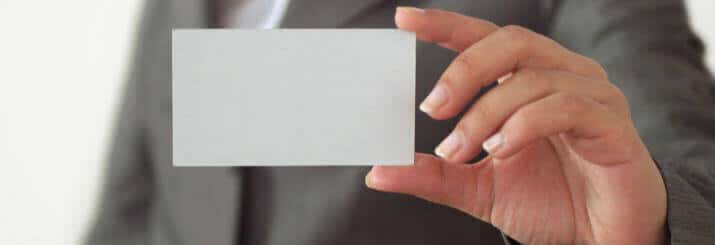Despite the move to everything digital, the exchange of a printed business card is time-tested tradition in face-to -face business interactions. Whether you are meeting a prospective client for the first time or at a networking event, your business card is a critical factor in making a good impression. Savvy, well-connected business people never leave home without a stack of effectively designed business cards in their wallet or purse, but what exactly constitutes an effective business card design? These five tips should give you some guidelines when looking to redesign your company’s business card:
Information: The main purpose of a business card is to make it easy for people to contact you. Include only the contact information that is absolutely necessary. For example, email, phone, cell, website, address, name and job title. You don’t need to provide a long list of services or every single mailing address if your company has multiple locations. There is very limited space on a business card, so by limiting the amount of textual information, the overall design will be cleaner and easier to read.
Brand: A business card conveys your brand by introducing brand elements, such as logo, colors and fonts. It is imperative that your business card to be consistent with your other branded materials. This helps to reinforce your brands, helping new acquaintances remember you and your company better.
Size: If you’ve ever thought about making your business cards larger, smaller, or even a fancy die cut to stand apart from your competition, there are advantages and disadvantages to consider. The typically business card size is 3.5” x 2”— meaning wallets and business card holders are designed to accommodate this size. If you business card won’t fit into these items, it may get tossed in the trash—making you lose out on potential business. So it’s best to create a design that stands out while fitting within those dimensions so that you’re newly made contacts can carry and store your information easily.
Paper: There are three things you want to consider when choosing the paper stock for your business card—weight, design, and finish. First you need your business card to be sturdy so it doesn’t get dented or torn in your wallet or business card holder. Just like a flimsy handshake doesn’t make a good impression; neither does a flimsy business card. Next, you want to consider the design of the card and what color paper and texture will compliment the design the best. Simple variations such as an off-white linen paper stock verses a bright white smooth paper stock will really impact the final product. Lastly, you want to consider the finish—is uncoated, matte or glossy the best? That’s up to the designer and printer—but its always nice to be able to jot down some additional information on your card if need be. Certain types of finishes or coats won’t allow this—such as glossy and certain matte finishes.
Design: The business card design itself must present both your contact information and brand elements on a very small space. So it is best to keep the design clean and organized. This can be achieved by making sure there is negative space on the card. Negative space allows your eyes to rest and focused your attention on what’s most important. Selecting appropriate fonts and font sizes is also important because it impacts the legibility. It’s best to select a font that is still legible at a small size—a classic serif or sans serif font would be your best bet. Lastly, you want to organize the content (information and branding elements) so that it’s user-friendly and visually appealing.
Having a strong, yet simple and easy to read business card design will present you as someone who is professional, savvy and tasteful—someone that is enjoyable to do business with. So before you begin your quest for the perfect business card design, keep these five tips in mind: information, brand, size, paper and design.



